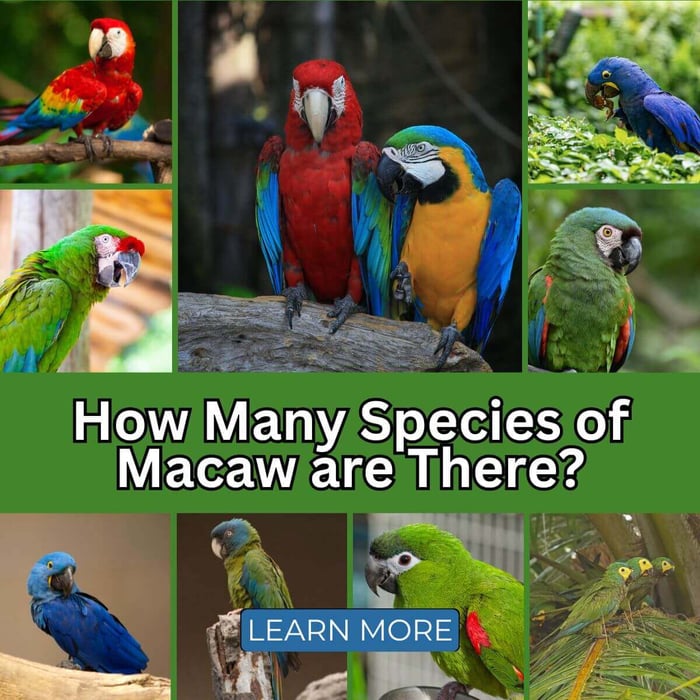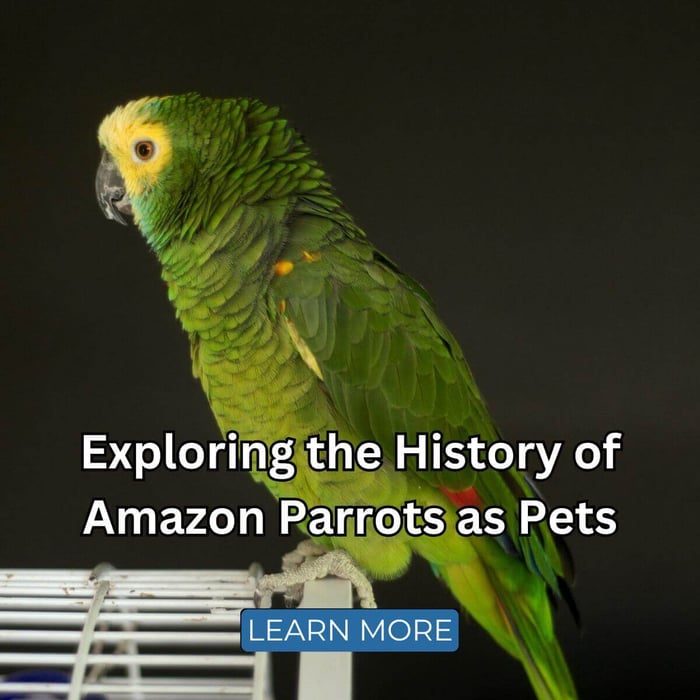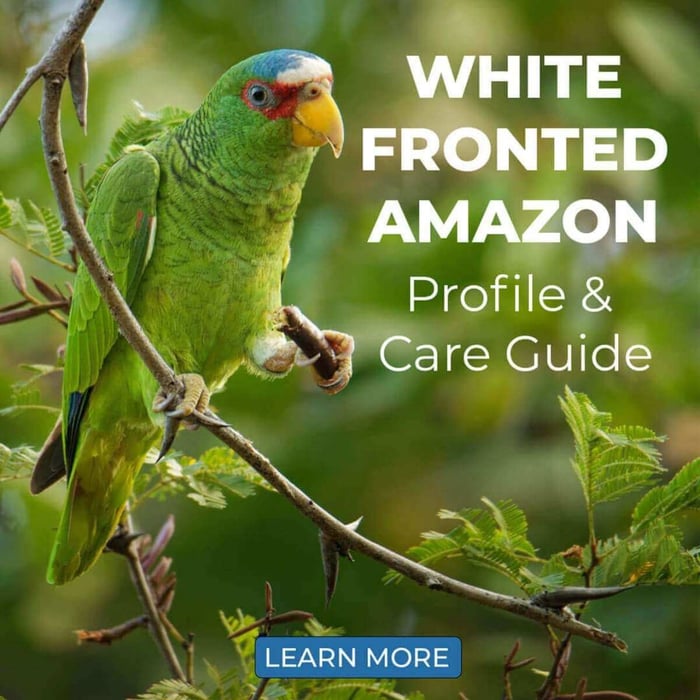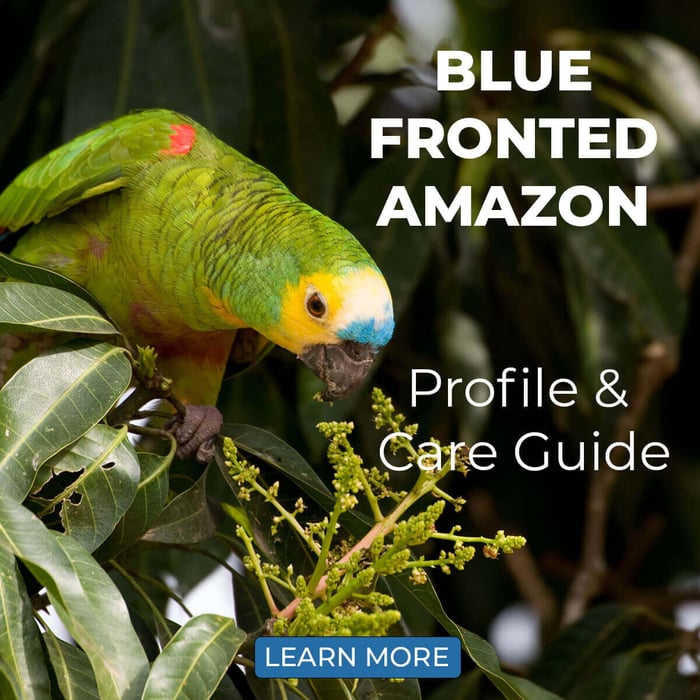What Are the Different Amazon Parrot Species?
Amazon parrots are some of the most intelligent, colourful, and engaging companion birds. Native to Central and South America and the Caribbean, these parrots are famous for their expressive personalities, mimicking abilities, and striking green plumage. With around 30 recognised species, each Amazon parrot has unique traits that make them special. Here's a guide to the most notable Amazon parrot species, with a glimpse into their characteristics.
Blue-fronted Amazon (Amazona aestiva)
One of the most popular pet Amazon parrot species, this bird is known for its vivid blue forehead, yellow cheeks, and vibrant green body. Blue-fronts are vocal and intelligent and can form strong bonds with their human companions. They thrive with attention and mental stimulation, and with proper socialisation, they can learn to mimic a wide range of words and sounds. These parrots enjoy interaction and can become quite attached to their caregivers. Regular out-of-cage time is essential for their mental and physical health. They have a long lifespan, often living 40 to 60 years in captivity.
Yellow-naped Amazon (Amazona auropalliata)
Easily recognised by the bright yellow patch on the back of the neck, the Yellow-naped Amazon is one of the best-talking Amazon parrot species in the world. These birds are social, smart, and affectionate but can become territorial if not properly socialised. Their ability to mimic human speech and sing entire songs has made them a favourite among parrot enthusiasts. They require consistent mental stimulation and enjoy complex toys and problem-solving games. They do best in homes where they are treated as part of the family and can be involved in daily activities. Early training and a routine environment help bring out their best qualities.
Double Yellow-headed Amazon (Amazona oratrix)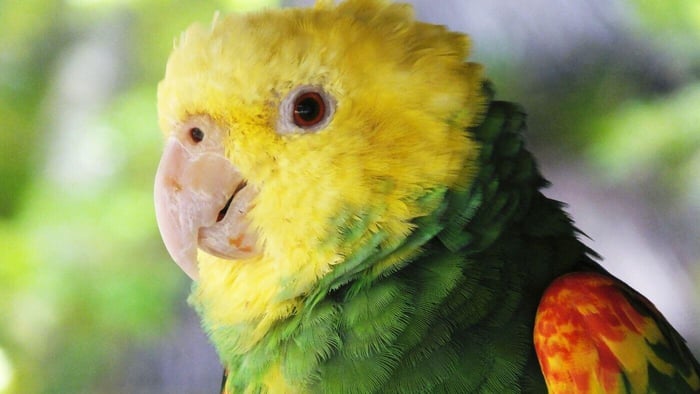
Famous for its dazzling yellow head and exceptional speaking ability, this Amazon is a top choice for those interested in a talking bird. These parrots are confident and theatrical, often enjoying centre stage in any household. Double Yellow-headed Amazons can become very bonded to one person and may exhibit jealous behaviours without proper training. They need a lot of interaction and mental stimulation to prevent boredom-related behaviours. Their vocal talents include imitating singing voices and even dramatic performances. As with all Amazon parrot species, a balanced diet and enrichment are key to their well-being.
Orange-winged Amazon (Amazona amazonica)
This species features subtle blue and yellow facial markings and distinct orange patches on the wings, visible in flight. They're known for their lively, sometimes moody personality and are common in aviculture. Orange-winged Amazons are less consistent talkers compared to others but are expressive in body language and enjoy social interaction. They need time outside the cage daily and do best with owners who understand their sometimes unpredictable moods. Their natural curiosity makes them eager to explore new toys and environments.
Red-lored Amazon (Amazona autumnalis)
Sporting a red forehead and yellow cheeks, the Red-lored Amazon is a charming parrot with a moderate talking ability. They're affectionate and enjoy being part of family activities. These birds are playful and curious, requiring regular enrichment to stay happy. While they may not talk as much as some other species, they make up for it with their gentle and sweet nature. Red-lored Amazons are often recommended for those seeking a slightly calmer Amazon parrot species.
Lilac-crowned Amazon (Amazona finschi)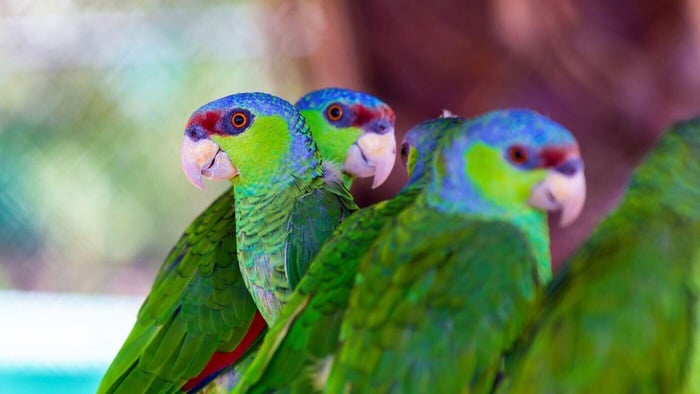
With a purplish crown and red highlights, this Amazon is slightly quieter and more reserved than others. They're gentle and often bond closely with one person, making them a good choice for a quieter home. Lilac-crowned Amazons are intelligent and responsive to training but may take more time to warm up to new people. Their calmer disposition makes them suitable for apartments or homes where excessive noise may be a concern. As a less commonly kept Amazon parrot species, they are a hidden gem among avian enthusiasts.
Mealy Amazon (Amazona farinosa)
One of the largest Amazon parrots, the Mealy, has a dusty or "mealy" green appearance. It is known for its calm disposition and quieter nature compared to other Amazons, making it ideal for owners seeking a more relaxed companion. They are gentle giants, often enjoying cuddles and quiet interaction. Mealy Amazons still need plenty of space and enrichment to stay content. Their large size makes them impressive birds, and they can develop extensive vocabularies with patient training.
White-fronted Amazon (Amazona albifrons)
The smallest of the Amazons, this species features a white patch on the forehead and bright red around the eyes. They're playful, curious, and tend to be less demanding than their larger cousins.
Yellow-shouldered Amazon (Amazona barbadensis)
This rare species has a unique yellow patch on the shoulders. Native to dry coastal forests of northern South America, it is critically endangered in the wild but loved for its inquisitive and energetic nature in captivity.
Cuban Amazon (Amazona leucocephala)
This colourful parrot has a white head and pinkish cheeks. Native to Cuba and nearby islands, they're active and social but require space to thrive.
Puerto Rican Amazon (Amazona vittata)
One of the world's most endangered birds, this Amazon is native solely to Puerto Rico. It has a green body with a blue flight feather and a red forehead. Conservation efforts are ongoing to protect this national treasure.
Vinaceous-breasted Amazon (Amazona vinacea)
With a distinctive purple-tinged chest, this Amazon is both beautiful and rare. Found in parts of Brazil, Paraguay, and Argentina, they are endangered due to habitat loss but are appreciated for their intelligence and affectionate temperament.
Kawall's Amazon (Amazona kawalli)
Sometimes mistaken for the Mealy Amazon, the Kawall's Amazon has a white patch around the eyes and darker plumage. A relatively recently rediscovered species, it is still being studied in the wild.
Lesser-Known Amazon Parrot Species
While many Amazon parrots are well-known in aviculture, several lesser-known or critically endangered species deserve attention:
- Southern Mealy Amazon (Amazona farinosa farinosa): A subspecies of the Mealy Amazon, slightly larger and more olive-toned, native to South America.
- Northern Mealy Amazon (Amazona farinosa guatemalae): Another Mealy subspecies found in Central America with similar traits.
- Scaly-naped Amazon (Amazona mercenarius): Found in the Andes, it has distinctive scale-like feathers on the back of the neck.
- Festive Amazon (Amazona festiva): Recognised by its red crown and blue cheeks, often found near rivers in South America.
- Red-tailed Amazon (Amazona brasiliensis): Endangered, native to Brazil’s Atlantic coast, with striking red undertail feathers.
- Green-cheeked Amazon (Amazona viridigenalis): Also known as the Red-crowned Amazon, this species is popular in the pet trade and has established feral populations in the U.S.
- Tucuman Amazon (Amazona tucumana): Similar in appearance to the Blue-fronted Amazon but found in Argentina and Bolivia.
- Yellow-billed Amazon (Amazona collaria): Endemic to Jamaica, easily identified by its pale yellow beak.
- St. Lucia Amazon (Amazona versicolor): Endemic to St. Lucia, colourful and critically protected.
- St. Vincent Amazon (Amazona guildingii): National bird of St. Vincent, large and endangered.
- Imperial Amazon (Amazona imperialis): Also known as the Dominican Amazon, it is large, striking, and critically endangered.
- Red-spectacled Amazon (Amazona pretrei): Recognisable by red markings around the eyes; native to Brazil.
- Blue-cheeked Amazon (Amazona dufresniana): Rare in captivity, native to northeastern South America.
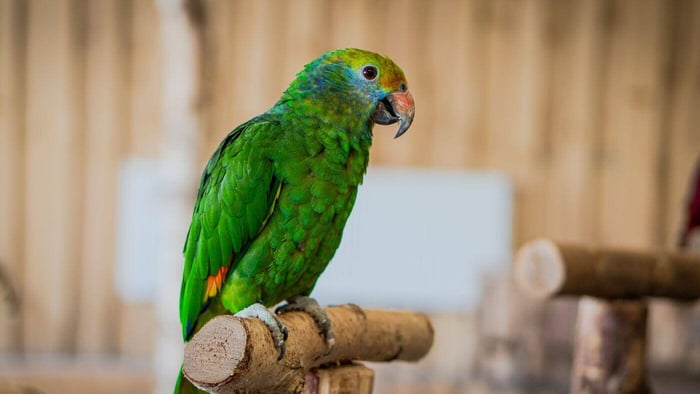
These species may not be as commonly kept as pets, but they are equally fascinating and often the focus of conservation efforts.
Popularity of Amazon Parrot Species as Pets
Amazon parrots have long held a beloved place in the world of pet birds thanks to their intelligence, vibrant colours, and incredible talking abilities. Among the most sought-after species are the Blue-fronted, Yellow-naped, and Double Yellow-headed Amazons, each known for their exceptional mimicry and engaging personalities. Their affectionate nature and high level of interaction make them ideal companions for experienced bird owners who can dedicate time to training and enrichment. However, their strong-willed characters and potential for loud vocalisations mean they may not be suited to every household. They are best kept by individuals or families who appreciate their need for mental stimulation, social engagement, and a structured environment. With proper care, Amazon parrot species can form deep bonds with their owners and live for decades, making them a rewarding but long-term commitment.
Final Thoughts
Amazon parrots are incredibly diverse, each species bringing a unique set of traits to the table. Whether you're looking for a brilliant talker, a gentle companion, or a lively addition to your home, there's an Amazon parrot species to suit every kind of bird lover. Just remember: they're long-lived, intelligent, and require a lifetime of commitment, care, and enrichment.
Looking to welcome an Amazon parrot into your home? Visit our parrot care blog and explore our collection of food, toys, and accessories specially curated for Amazon parrots!
FAQs
Are Amazon parrots good for first-time bird owners?
Amazon parrots can be challenging for beginners due to their intelligence, strong personalities, and need for daily interaction. They're best suited for experienced or committed bird owners who can provide consistent training and mental stimulation.
How long do Amazon parrots live?
With proper care, many Amazon parrots live 40 to 60 years, and some can even reach 70+ years in captivity. They are a long-term commitment.
Can all Amazon parrots talk?
Not all Amazon parrots are great talkers, but many species—like the Yellow-naped, Double Yellow-headed, and Blue-fronted Amazon—are known for excellent mimicry and clear speech.
Do Amazon parrots need a lot of attention?
Yes! Amazon parrots are highly social and intelligent. They thrive on interaction, out-of-cage time, and mental enrichment. Boredom can lead to behavioural issues like screaming or feather plucking.
What should I feed an Amazon parrot?
A balanced diet should include high-quality parrot pellets, fresh fruits and vegetables, and occasional seeds or nuts. Always avoid foods high in fat, salt, or sugar, and consult an avian vet for tailored diet advice.

